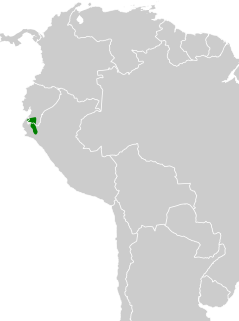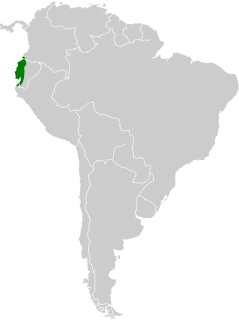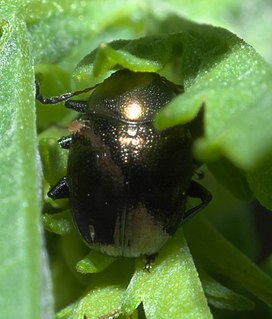
The amazilia hummingbird is a hummingbird in the "emeralds", tribe Trochilini of subfamily Trochilinae. It is the only species placed in the genus Amazilis. It is found in Ecuador and Peru. Its six subspecies differ primarily in their throat and belly colors.

The chestnut-backed antbird is a passerine bird in the antbird family. It is found in humid forests in Central and South America (Chocó-Magdalena), ranging from eastern Nicaragua to western Ecuador. It mainly occurs in lowlands up to an altitude of 900 metres (3,000 ft) m, but locally it occurs higher.

The dark long-tongued bat is a species of bat from South and Central America. It was formerly considered monotypic within the genus Lichonycteris, but is now recognized as one of two species in that genus, along with the pale brown long-nosed bat. It is small species of bat, with adults weighing 6–11 g (0.21–0.39 oz) and having a total length of 46–63 mm (1.8–2.5 in).

The pale-browed tinamou is a type of tinamou found in tropical dry forests in Peru and Ecuador.
Engystomops pustulatus is a species of frog in the family Leptodactylidae. It is known with certainty from western Ecuador, whereas the status of Peruvian records is ambiguous as they may refer to an undescribed species or possibly Engystomops puyango. Nevertheless, given that E. pustulatus is now known from Huaquillas in southern Ecuador, near the Peruvian border, it is likely to be found in Peru too.

The tawny-crowned greenlet is a species of bird in the family Vireonidae and is the only species placed in the genus Tunchiornis. It is found in Belize, Bolivia, Brazil, Colombia, Costa Rica, Ecuador, French Guiana, Guatemala, Guyana, Honduras, Mexico, Nicaragua, Panama, Peru, Suriname, and Venezuela. Its natural habitat is subtropical or tropical moist lowland forest.

The grey-headed antbird is a species of bird in the family Thamnophilidae. It is found in Ecuador and Peru.

The ocellated antbird is a species of antbird in the family Thamnophilidae. It is monotypic within the genus Phaenostictus and is found in southern Central America and the northwestern part of South America. Its natural habitat is the understory of tropical moist lowland forest, foothill forest, and tall secondary growth woodlands.

The blue-and-yellow tanager is a species of bird in the tanager family Thraupidae.

The equatorial dog-faced bat is a species of bat in the family Molossidae. It is endemic to Ecuador. They are found in dry, tropical forests. The species is now endangered. The equatorial dog-faced bat feeds on insects.

Pristimantis is a very large genus of frogs distributed in the southern Caribbean islands and in Central and South America from Honduras to northern Argentina and southern Brazil. With 596 described species, the genus had more species than any other genus of vertebrate animals. Many of these species genus are endemic to the Northwestern Andean montane forests ecoregion in north-western South America.

Zeledon's antbird is a species of antbird in the family Thamnophilidae. It is found at low levels in humid forests from Nicaragua to Panama, and in the Chocó of western Colombia and western Ecuador. Zeledon's antbird feeds on insects, and regularly follows swarms of army ants in order to catch prey flushed by the swarms, but it is not an obligate ant-follower like some species of antbirds.

The Ecuadorian dry forests (NT0214) is an ecoregion near the Pacific coast of the Ecuador. The habitat has been occupied by people for centuries and has been severely damaged by deforestation, overgrazing and hillside erosion due to unsustainable agriculture. Only 1% of the original forest remains. The patches of forest, mostly secondary growth, are fragmented. They are home to many endemic species at risk of extinction.

The Matapalo broad-nosed bat, Platyrrhinus matapalensis, is a species of leaf-nosed bat described in 2005. It is found in South America.

Eumolpini is a tribe of leaf beetles in the subfamily Eumolpinae. It is the largest tribe in the subfamily, with approximately 170 genera found worldwide. Members of the tribe almost always have a longitudinal median groove on the pygidium, which possibly helps to keep the elytra locked at rest. They also generally have a subglabrous body, as well as appendiculate pretarsal claws.
Aphilenia is a genus of leaf beetles in the subfamily Eumolpinae. It is distributed in Central and East Asia as well as southern Russia. Members of the genus are adapted to dry climates, and feed on bushes of the genus Calligonum. In 2012, the genus was moved from the tribe Bromiini to the tribe Nodinini.
Apterodina is a genus of leaf beetles in the subfamily Eumolpinae. It is known from Brazil, Colombia and Ecuador. It was first described by the Czech entomologist Jan Bechyné in 1954. All species of the genus have greatly reduced hind wings.
Tricholapita is a genus of leaf beetles in the subfamily Eumolpinae. The genus is endemic to New Caledonia.













